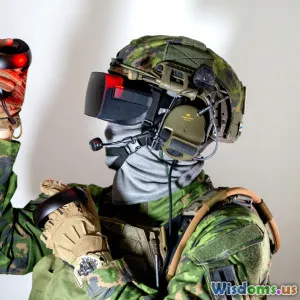
Future Weapons: Shaping Tomorrow's Battlefield
6 min read Explore the advancements in military technology and future weapons that will redefine warfare. (0 Reviews)
Future Weapons: Shaping Tomorrow's Battlefield
Introduction
As we advance into the 21st century, the landscape of warfare is rapidly evolving. Military technology is at the forefront of this transformation, with innovations promising to redefine how conflicts are fought. From artificial intelligence to robotic systems and hypersonic missiles, future weapons are being developed that not only enhance combat effectiveness but also raise ethical and strategic questions. This article delves into the technologies shaping tomorrow's battlefield and their implications for global security.
The Role of Artificial Intelligence
Artificial Intelligence (AI) is perhaps the most significant force shaping future military capabilities. AI systems can analyze vast amounts of data rapidly, providing real-time intelligence that enhances decision-making. For example, the U.S. Department of Defense is investing heavily in AI to improve drone operations, predictive maintenance for equipment, and battlefield simulations. AI-driven systems can identify targets with unprecedented accuracy, thus reducing collateral damage and increasing mission success rates.
Robotics and Autonomous Systems
Robotic technology is transforming the battlefield, making it safer and more efficient. Unmanned vehicles, both aerial and ground-based, are now deployed for reconnaissance and combat missions. For instance, the use of drones has become standard in modern warfare, allowing forces to gather intelligence without risking human lives. Autonomous systems, such as the U.S. Army's Robotic Combat Vehicle program, are being developed to support troops in frontline operations, perform logistics, and even engage enemies in combat scenarios.
Hypersonic Weapons
Hypersonic technology represents a significant leap in missile capabilities. These weapons travel at speeds greater than Mach 5, making them extremely difficult to detect and intercept. Countries like Russia and China are leading the charge in hypersonic missile development, prompting the U.S. to accelerate its own programs. The ability to strike targets within minutes changes the strategic calculus of deterrence and defense, compelling nations to rethink their military strategies.
Directed Energy Weapons
Another innovative technology gaining traction is directed energy weapons (DEWs), which include lasers and microwave systems. DEWs offer the potential for precise, cost-effective targeting with minimal collateral damage. The U.S. Navy, for example, has successfully tested laser systems capable of disabling drones and small boats with pinpoint accuracy. As these systems become more reliable and powerful, they could become a mainstay in both offensive and defensive military operations.
Cyber Warfare
As military technology evolves, so does the battlefield's cyber dimension. Cyber warfare has become an integral part of military strategy, with nations investing in capabilities to defend against and conduct cyberattacks. Ensuring cybersecurity for military networks is critical, as vulnerabilities can lead to catastrophic failures in communication and operational effectiveness. Governments are now prioritizing cyber defense alongside traditional military capabilities.
Ethical Considerations and Future Challenges
The advancement of military technology raises ethical and moral questions. The use of autonomous weapons systems, for instance, sparks debates about accountability in warfare. Who is responsible when an AI-driven drone makes a mistake? Furthermore, the proliferation of advanced military technologies can lead to an arms race, increasing global instability. Balancing technological advancement with ethical considerations will be crucial for future military leaders.
Conclusion
The battlefield of the future will be shaped by remarkable advancements in military technology. AI, robotics, hypersonic weapons, directed energy systems, and cyber warfare capabilities are all poised to redefine how conflicts are conducted. While these innovations promise increased effectiveness and safety, they also introduce complex ethical dilemmas and strategic challenges. As we move forward, a balanced approach that considers both the benefits and risks of these technologies will be essential in ensuring global security and maintaining peace.
References
- U.S. Department of Defense: Artificial Intelligence Strategy 2020
- National Defense Magazine: The Rise of Hypersonics
- IEEE Spectrum: The Future of Directed Energy Weapons
- Cybersecurity & Infrastructure Security Agency: Cyber Defense Strategies
Rate the Post
User Reviews
Popular Posts

















